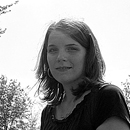Each Wednesday, I write a post from my dissertation.
Many scrapbookers, if not most, edit photographs in one way or another. Photographs are edited from the beginning—when the photographer decides to take a photograph, something else remains unphotographed—to the end—when photo-editing software can be used to improve photo quality or cut out undesirable elements (people or things).
Photographs are further edited through the selection of choosing which printed photos to include in the scrapbook and if any further editing should occur. Critics overstate the role of photo-editing in scrapbooking. True, photo editing software is used to “eliminate [everything from] red-eye to a deadbeat dad” (Helfand 2008:169), but my respondents report that most photo-editing involves the former (i.e., red-eye), and very rarely involves the latter (i.e., deadbeat dad).
Photo editing is an important part of the storytelling in scrapbooking. For example, cropping a photograph may be used to direct the viewer’s focus to what the scrapbooker feels is important. In other cases, a photo is cropped after it has been printed so that more photographs will fit on the scrapbook page. Here the issue space, without the intent of changing the story. Other times a scrapbooker may crop a photograph to provide interest or artistry on the page. For example, a photograph may be cut into a circle or a triangle to break up the monotony of rectangles (the standard printed shape of photographs). Cropping may also be done to eliminate “empty space.” Empty space most often is the background—the sky, water, or a wall—nothing of interest (i.e., white space).
Photo editing changes shape as scrapbookers become more experienced scrapbookers and photographers. At this point, the scrapbooker often begins taking pictures with their scrapbook in mind–meaning, the photo editing occurs before the photo is even taken. For example, a respondent mentions how she takes photographs differently by trying to eliminate as much “junk” (e.g., an empty potato chip bag in the background) from the image before even taking the photograph and discusses what she plans to do differently on her next outing (e.g., using an actual picnic basket instead of plastic grocery bags is better for the photograph). Here the editing begins before the photograph is even made. Some items cannot be removed from the view of the camera as one respondent reports regularly removing a facial mole from his face with photo editing software.
Industry workers actually caution scrapbookers from cropping too many photographs or too much of a photo because things that seem unimportant now may be very important in the future (e.g., a painting on the wall at your grandparents’ house seems unimportant in a photo of your grandparents now but later, that painting may serve as an important reminder of your grandparents). Back to the example of the potato chip bag…that bag might date the photograph. Think about it. Does the brand of potato chips that you ate as a child still manufactured? Is it a flavor that is not longer sold? The point is that clutter or noise could trigger memories that otherwise would be lost.
Occasionally, photographs are edited as they are taken. A scrapbooker in my study used a camera that can merge two photos together. She showed me the resulting photograph. One click of the camera recorded her husband next to a sign and the next click recorded her next to the sign. The final photograph is of the two of them next to the sign as if they both really had been in front of the camera at the same time. Unfortunately, this camera setting is imperfect in that the merged photos did not match up evenly so upon close examination, one can tell the photo had been edited and that husband and wife were not really standing next to the same sign at the exact moment the camera clicked.
Photographs are also edited for artistic reasons.. For example, a scrapbooker in my study tinted all of his photos from a trip to the beach blue to better go with the beach theme of sky and water. Photographs are edited, but rarely in ways to intentionally mislead the viewer.
How about you? Do you frame your photographs to exclude some things or people from the shot? Do you edit your photos before they are printed? Do you edit photos after they are printed? What do you think? Comment below and join the conversation on facebook.
Reference:
Helfand, Jessica. 2008. Scrapbooks: An American History. New Haven, CT: Yale University Press.
Stephanie
Did you know that you can get Scrapworthy Lives delivered to your inbox? Join the Email List so you never miss a post! You will receive no more than two emails a week from this list. Subscribers will be the first to learn about any new products and promotions at Scrapworthy Lives. Subscribe in the upper right side of the page. Thanks!


 Stephanie Medley-Rath is a sociologist and scrapbooker who studies scrapbooking and memory keeping. Scrapworthy Lives is a blog focused on her sociological analysis of scrapbooking, with a sprinkling of posts about Stephanie's own scrapbooking projects.
Stephanie Medley-Rath is a sociologist and scrapbooker who studies scrapbooking and memory keeping. Scrapworthy Lives is a blog focused on her sociological analysis of scrapbooking, with a sprinkling of posts about Stephanie's own scrapbooking projects.

2 Responses to Is Editing Photographs being Dishonest?